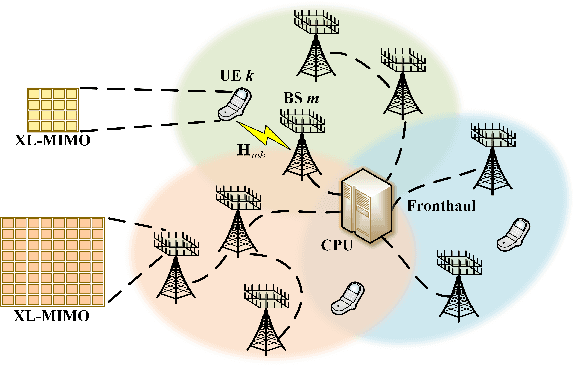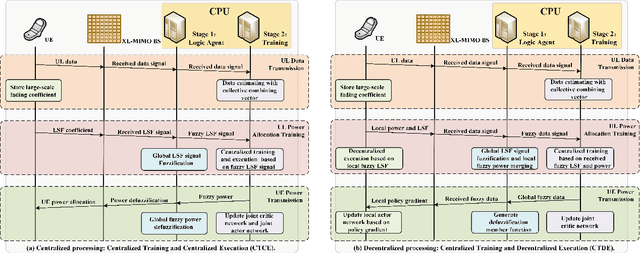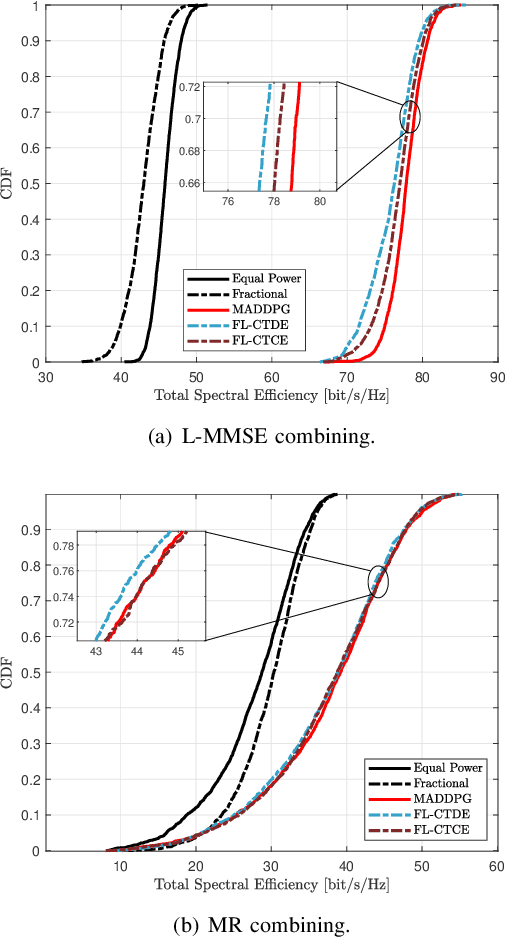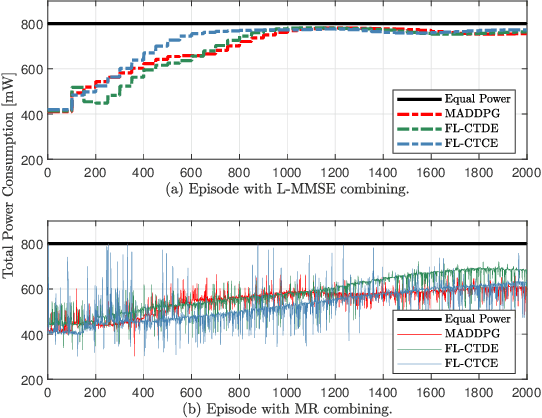Zhilong Liu
Double-Layer Power Control for Mobile Cell-Free XL-MIMO with Multi-Agent Reinforcement Learning
Sep 29, 2023Abstract:Cell-free (CF) extremely large-scale multiple-input multiple-output (XL-MIMO) is regarded as a promising technology for enabling future wireless communication systems. Significant attention has been generated by its considerable advantages in augmenting degrees of freedom. In this paper, we first investigate a CF XL-MIMO system with base stations equipped with XL-MIMO panels under a dynamic environment. Then, we propose an innovative multi-agent reinforcement learning (MARL)-based power control algorithm that incorporates predictive management and distributed optimization architecture, which provides a dynamic strategy for addressing high-dimension signal processing problems. Specifically, we compare various MARL-based algorithms, which shows that the proposed MARL-based algorithm effectively strikes a balance between spectral efficiency (SE) performance and convergence time. Moreover, we consider a double-layer power control architecture based on the large-scale fading coefficients between antennas to suppress interference within dynamic systems. Compared to the single-layer architecture, the results obtained unveil that the proposed double-layer architecture has a nearly24% SE performance improvement, especially with massive antennas and smaller antenna spacing.
Cell-Free XL-MIMO Meets Multi-Agent Reinforcement Learning: Architectures, Challenges, and Future Directions
Jul 06, 2023Abstract:Cell-free massive multiple-input multiple-output (mMIMO) and extremely large-scale MIMO (XL-MIMO) are regarded as promising innovations for the forthcoming generation of wireless communication systems. Their significant advantages in augmenting the number of degrees of freedom have garnered considerable interest. In this article, we first review the essential opportunities and challenges induced by XL-MIMO systems. We then propose the enhanced paradigm of cell-free XL-MIMO, which incorporates multi-agent reinforcement learning (MARL) to provide a distributed strategy for tackling the problem of high-dimension signal processing and costly energy consumption. Based on the unique near-field characteristics, we propose two categories of the low-complexity design, i.e., antenna selection and power control, to adapt to different cell-free XL-MIMO scenarios and achieve the maximum data rate. For inspiration, several critical future research directions pertaining to green cell-free XL-MIMO systems are presented.
Uplink Power Control for Extremely Large-Scale MIMO with Multi-Agent Reinforcement Learning and Fuzzy Logic
Feb 18, 2023



Abstract:In this paper, we investigate the uplink transmit power optimization problem in cell-free (CF) extremely large-scale multiple-input multiple-output (XL-MIMO) systems. Instead of applying the traditional methods, we propose two signal processing architectures: the centralized training and centralized execution with fuzzy logic as well as the centralized training and decentralized execution with fuzzy logic, respectively, which adopt the amalgamation of multi-agent reinforcement learning (MARL) and fuzzy logic to solve the design problem of power control for the maximization of the system spectral efficiency (SE). Furthermore, the uplink performance of the system adopting maximum ratio (MR) combining and local minimum mean-squared error (L-MMSE) combining is evaluated. Our results show that the proposed methods with fuzzy logic outperform the conventional MARL-based method and signal processing methods in terms of computational complexity. Also, the SE performance under MR combining is even better than that of the conventional MARL-based method.
 Add to Chrome
Add to Chrome Add to Firefox
Add to Firefox Add to Edge
Add to Edge